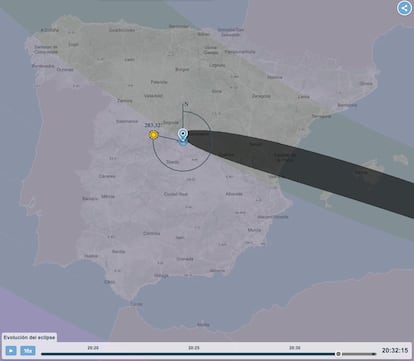Spain now has the official map of the total eclipses of 2026 and 2027 so you can see them.


Spain is preparing to host a trio of eclipses unprecedented in modern history , attracting a large influx of tourists concentrated around the days of the two total eclipses—August 12, 2026, and August 2, 2027. And right in the middle of the summer peak season, the mass travel that these astronomical phenomena always provoke promises to break records. In light of this event, the launch of a web portal ( eclipses.ign.es ) with official data and maps for planning observations is the Spanish government's first move, with one year and one month to go until the first of the highest-category eclipses that will pass over the Iberian Peninsula in the next three years.
In Spain, the National Geographic Institute (IGN) is responsible for preparing official information on astronomical events. It has created this new website to compile and display the calculations made by the National Astronomical Observatory for all 8,132 Spanish municipalities. An interactive map is the major innovation of this new tool for "planning eclipse observation in detail from anywhere in Spain," according to the Ministry of Transport, to which the IGN is affiliated.
The viewer allows you to search by location and even by street, showing the magnitude and duration of the eclipse in each location. Based on official maps, it shows, for example, how almost the entire city of Madrid will be outside the path of totality for the eclipse on August 12, 2026. In the center of the Spanish capital, the occultation will be 99.96%; however, experts emphasize that such a pronounced partial eclipse has little to do with the sensations of a total eclipse, which will be visible for a few seconds around 8:32 p.m. from some streets in the northernmost neighborhoods of the city and from Adolfo Suárez Madrid-Barajas Airport.
However, that same day, it will be almost nighttime for 1 minute and 44 seconds in the Cañón del Río Lobos Natural Park , located in Soria. The central line of the eclipse, which marks the locations where the phase of totality lasts the longest, crosses the province diagonally. The 2026 total eclipse is beginning to be known as "the eclipse of empty Spain," as a large, sparsely populated rural area in the provinces of León, Palencia, Burgos, and Soria will initially be the ideal area to observe the astronomical phenomenon. This is due to the path of the shadow marked by the total eclipse, the low probability of clouds, and the flat terrain, with no major relief features.
On August 12, 2026, Spain will be the only country in the world where the total eclipse can be safely viewed. After rising in the Arctic, passing over Greenland and grazing the western tip of Iceland, it will continue across the sea until it reaches the Galician and Asturian coasts at 7:30 p.m. It will become total almost an hour later. The band of totality will cross northern Spain toward the coasts of Valencia, Alicante, and Tarragona, and then pass over the Balearic Islands just before ending in the Mediterranean Sea. Outside of this band, the eclipse will be partial in the rest of Spain, with a high percentage of occultation across the Iberian Peninsula.
The Iberian Peninsula hasn't seen a total eclipse since 1912, although one did pass over the Canary Islands in 1959. The major drawback of this unique event for Spain, as the IGN warns, is that the country is located "at the end of the path of totality, so it will occur as the sun is setting." Therefore, obstacles near the horizon—such as buildings, trees, and mountains—can impede viewing of the eclipse. The IGN promises that it will soon "provide detailed information on viewing conditions in each Spanish geographic location, taking into account the terrain." However, with the current viewer, it's already easy to see that it won't be visible in towns like San Lorenzo del Escorial (Madrid), located on the side of a mountain that blocks the sun at sunset.
And in the days leading up to the astronomical event, this website will also include cloud forecasts provided by the Spanish State Meteorological Agency (AEMET); for now, only average data from the past few decades are available. These will serve as a guide to which areas of the totality are most likely to experience clear skies in early August.
Tips for the Iberian trio of eclipsesAlmost exactly a year later, on the morning of August 2, 2027 , another eclipse will cross Spain, but it will only be total in the southern tip of Andalusia, which is already saturated with visitors on those dates. This eclipse will have the advantage of a longer totality phase and will occur higher above the horizon, when the sun is still rising. "The maximum duration of totality will occur in Ceuta, at 4 minutes and 48 seconds," explains the IGN.
And as the culmination of this historic season of top-tier eclipses, on the evening of January 26, 2028, an annular eclipse will cross the Peninsula from southwest to northeast, just before sunset. Therefore, observing it "will require excellent visibility in the direction of the setting sun," according to the website with all the official data for the trio of eclipses.
In addition, this new website also provides safety recommendations for observing eclipses safely, providing informative information on the science of eclipses , and also on their impact on history , art, and mythology. Following the launch of this website, Spain's leading center for astronomical information on eclipses has announced that it will continue its outreach campaign with the publication of several publications and the organization of courses and conferences.
EL PAÍS


%3Aformat(jpg)%3Aquality(99)%3Awatermark(f.elconfidencial.com%2Ffile%2Fbae%2Feea%2Ffde%2Fbaeeeafde1b3229287b0c008f7602058.png%2C0%2C275%2C1)%2Ff.elconfidencial.com%2Foriginal%2Ff2d%2F4ec%2Fd5a%2Ff2d4ecd5ac70176b0635e88125f7a050.jpg&w=1280&q=100)
%3Aformat(jpg)%3Aquality(99)%3Awatermark(f.elconfidencial.com%2Ffile%2Fbae%2Feea%2Ffde%2Fbaeeeafde1b3229287b0c008f7602058.png%2C0%2C275%2C1)%2Ff.elconfidencial.com%2Foriginal%2Fb94%2F67e%2Fe68%2Fb9467ee6867d7954e897612e011e3c1c.jpg&w=1280&q=100)
%3Aformat(jpg)%3Aquality(99)%3Awatermark(f.elconfidencial.com%2Ffile%2Fbae%2Feea%2Ffde%2Fbaeeeafde1b3229287b0c008f7602058.png%2C0%2C275%2C1)%2Ff.elconfidencial.com%2Foriginal%2F69b%2Fbe9%2F104%2F69bbe9104fd31cd3d0f75467f1346047.jpg&w=1280&q=100)